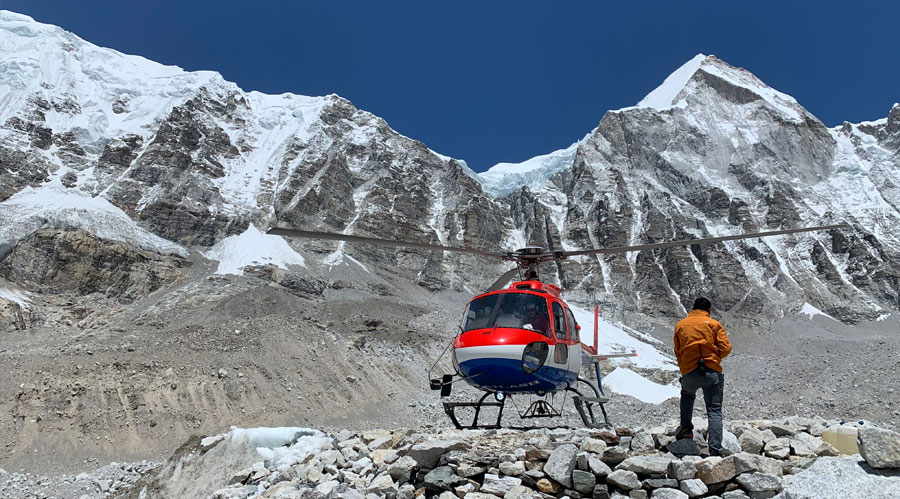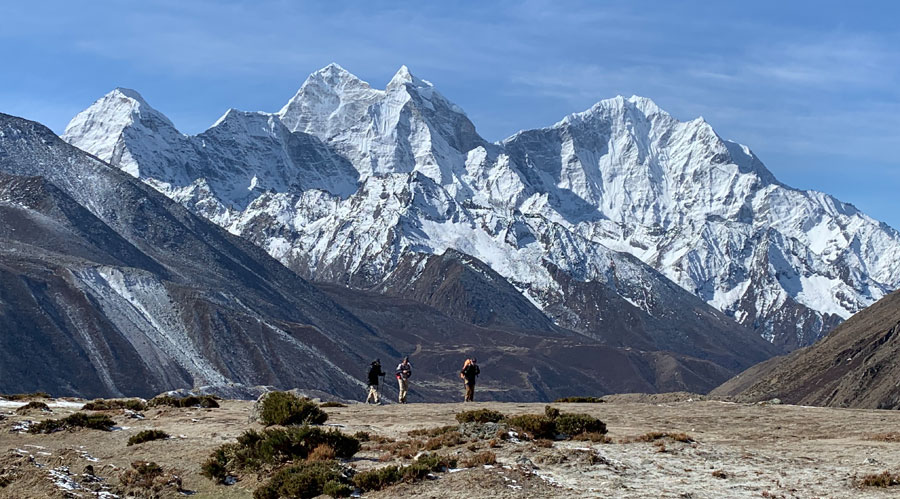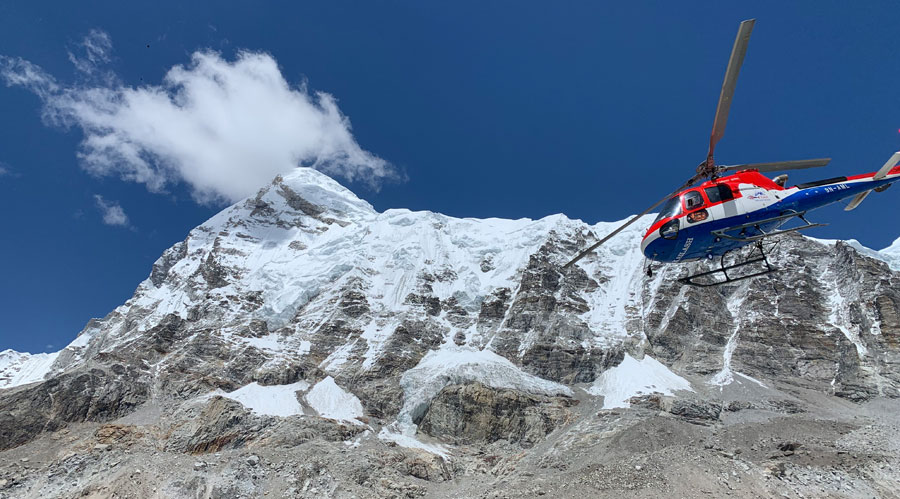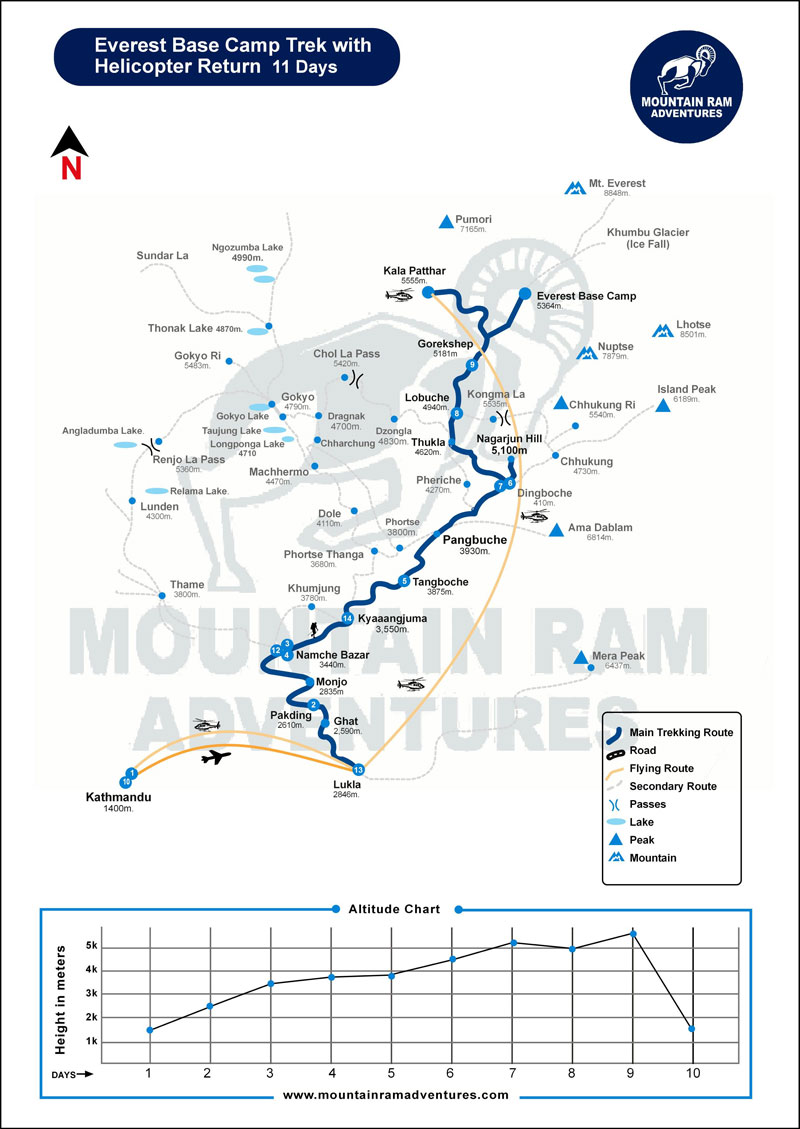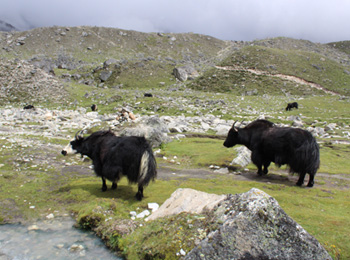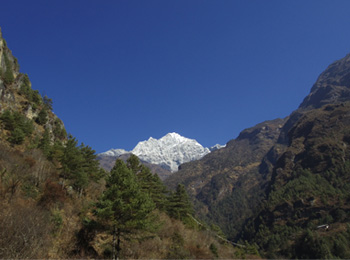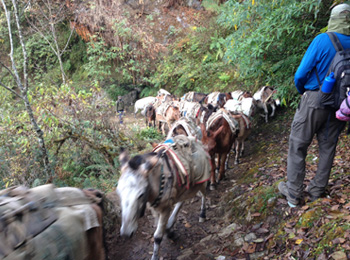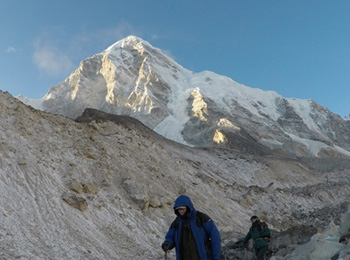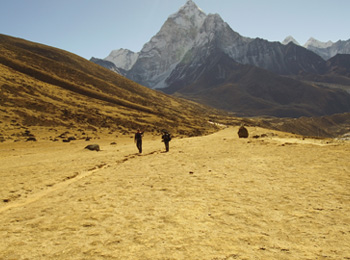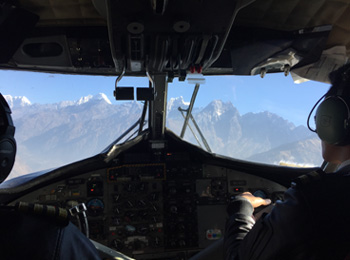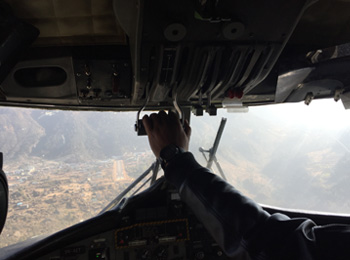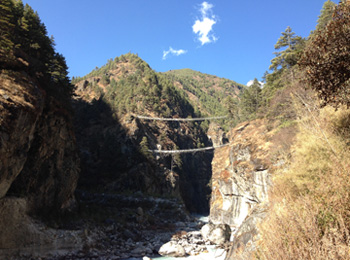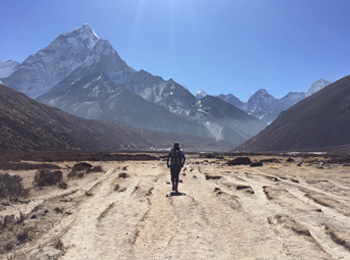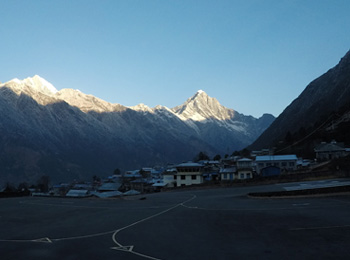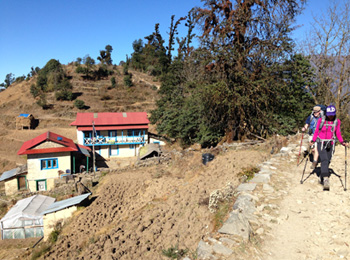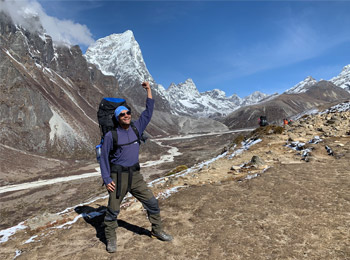- +977 9851074270
- info@mountainramadventures.com
Trip Highlights
- Trek to Everest base camp and take an exhilarating helicopter flight from Kala Patthar back to Kathmandu
- Complete the EBC trek just in 11 days while enjoying a spectacular aerial panorama of the Himalayas
- Trek through rhododendron and magnolia forests, crossing numerous hanging bridges and narrow streams
- Immerse yourself in the rich Nepali culture, traditions, and warm hospitality of the local Sherpa community
- Spend a couple of nights in Namche Bazaar, the tourist of the Khumbu region
- Hike to Hotel Everest View and Nagarjuna Hill for acclimatization and witness gorgeous sunrise and mountain views
- Enjoy offbeat trail in the later part of the trek through glaciers, moraines, and rocky gorges
- Witness breathtaking mountain vistas throughout the trek, including iconic peaks like Mt. Everest, Mt. Lhotse, Mt. Nuptse, Mt. AmaDablam, and many more
Detail About Everest Base Camp Trek with Helicopter Return
The Everest base camp trek with helicopter return is not much different from the classic 14 days or 16 days EBC trek. The only major difference is upon reaching Kala Patthar (5,644 m/18,519 ft), the highest point of this trek, you will take a helicopter flight to Kathmandu instead of trekking back to Lukla (2,846 m/9,337 ft) and flying commercial. You get to avoid 2 to 3 days of exhausting descent and complete the Everest base camp trek in 11 days.
This is also one of our best short trekking itineraries for the Everest base camp. The helicopter flight at the end of the trek makes the journey much more adventurous and lets you behold breathtaking aerial mountain landscapes, which very few travelers get to enjoy. We, Mountain Ram Adventures, are welcoming people of all ages and backgrounds to join us on this adventurous trek to the lowkey top of the world.
On this 11 days trip to Nepal, you will be learning about Nepali people, culture, tradition, and mountains. From the bustling city of Kathmandu to the base of the highest mountain in the world, Everest base camp (5,364 m/17,598 ft), the trek offers a life-changing experience. Leaving the modern comfort behind, you will embark on an adventure of a lifetime amidst towering Himalayan mountains, deep river valleys, and picturesque Sherpa villages.
Every day holds a new adventure, whether it be crossing a hanging suspension bridge, lush rhododendron forests, steep farming fields, small settlements, rushing rivers, narrow streams, cascading waterfalls, or rocky gorges. At every turn, you will be surprised by spectacular landscapes and mountain vistas. And as the trail gradually climbs and opens up, the majestic mountains and glaciers unfold themselves.
About the villages, locals, and monasteries in the Everest region
When talking about trekking to Mount Everest base camp, it's inevitable to overlook the cultural heritage, flora & fauna, and the little moments one gets to experience during the trek because of all the hype around the adventure part. However, the villages along the trail and the interactions with the locals make the journey much more meaningful and memorable.
One of the highlights of the EBC trek is the Sherpa community. Namche Bazaar (3,440 m/11,290 ft) is the biggest Sherpa settlement in the Khumbu region, where you will spend a couple of nights. During your stay in Namche Bazaar and other villages such as Phakding (2,610 m/8,563 ft), Tengboche (3,860 m/12,660 ft), Dingboche (4,410 m/14,470 ft), and Lobuche (4,940 m/16,210 ft), you will learn a lot about them. Get to know their daily lifestyle and beliefs.
The locals are very friendly and welcoming. You will have a great time interacting with them and learning about their life. Similarly, there are many small and big monasteries, stupas, chortens, and prayer wheels scattered around the trail. Tengboche monastery and Pangboche monastery are two significant religious points in the Khumbu region. You will visit both of them during trekking.
The trekking route and the mountain views
The Everest base camp trekking route has a mixed terrain. Trekking through subtropical forests, you will ascend to alpine woods and pass by bushes before going above the treeline. The trail then goes past glaciers and moraines to Everest base camp. The upper part of the trail is much more rocky and steep.
In the first few days of the trek, you get to see views of Kongde Ri (6,187 m/20,299 ft), Khumbila (5,761 m/18,901 ft), Thamserku (6,608 m/21,680 ft), etc. From Everest View Hotel, you will witness the first view of Mt. Everest (8,849 m/29,032 ft), Mt. Lhotse (8,516 m/27,940 ft), Mt. Nuptse (7,861 m/25,791 ft), and Mt. Ama Dablam (6,812 m/22,349 ft).
Later along the way, mountains like Pumori (7,161 m/23,494 ft), Makalu (8,481 m/27,825 ft), Cholatse (6,440 m/21,130 ft), Chamlang (7,319 m/24,012 ft), etc come into view. The landscape changes drastically towards the end of the trek. The final helicopter flight from Kala Patthar adds more spectacular scenery to the journey.
What are acclimatization days, and why is it important?
The acclimatization days are rest days in between the trek. We have two acclimatization days in our Everest base camp trek with helicopter return itinerary. One is in Namche Bazaar, and the other is in Dingboche village. The golden rule to avoid altitude sickness during trekking is by ascending higher and sleeping low.
As the trail ascends every day, we take acclimatization days to spend a couple of nights in the same village and go on a hike to adjust to the elevation. For a successful and safe venture, acclimatization days are crucial. It will also provide you the opportunity to enjoy the trip and spend more time with the locals.
For the acclimatization hike in Namche Bazaar, you will go to Hotel Everest View (3,962 m/13,000 ft), and in Dingboche, hike to Nagarjuna Hill (5,100 m/16,732 ft). The hike offers gorgeous sunrises and a fantastic mountain landscape.
The helicopter flight from Kala Patthar
The helicopter flight from Kala Patthar first takes a round over the Everest base camp and Khumbu Icefall. Enjoying a stunning view of Khumbu Glacier, you will fly over the path you took earlier and gradually descend to Lukla. At Lukla, we will land for a few minutes to refuel the chopper and continue the flight to Kathmandu. From Kala Patthar, it takes 15 minutes to reach, and from Lukla, you will reach Kathmandu in a 45 minutes helicopter flight.
Extend the trek to Gokyo Lakes or cross one of the three high passes of the Everest region
If you want to extend your Everest base camp short trek, feel free to share your requirements with us. In the Khumbu region, you can extend the trek to the famous Gokyo Lakes or cross a high mountain pass like Cho La or Renjo La. This part of the Khumbu region is more challenging than the EBC trail, so make your choice as per your fitness.
Alternative trekking packages in Nepal
We have many trekking and tour packages in Nepal. These are some of our hand-picked itineraries for beginner trekkers- Everest View trek, Ghorepani Poon Hill trek, Langtang Valley trek, Mardi Himal trek, Khopra Danda trek, and Pikey Peak trek.
If you are an experienced trekker and looking for a challenging trail, then check out these packages- Annapurna Circuit trek, Manaslu Circuit trek, Upper Mustang trek, Annapurna Circuit with Tilicho Lake trek, Langtang Gosaikunda trek, and Makali base camp trek.
Do note that you can customize any trek with us. We organize special treks too for travelers who are in quest of a unique venture in the Himalayas. Your dream journey is only one step away from contacting us!
Benefits of using Mountain Ram Adventures for EBC trekking with helicopter return
Below are the benefits you will get by doing this trek with us:
- We guarantee the success of your Everest base camp trekking expedition, barring any unforeseen circumstances, and ensure a safe and memorable experience.
- With over two decades of experience in the industry, our expertise is unparalleled, ensuring that all aspects of your trek are meticulously planned and executed.
- Our experienced team will take care of all your trekking arrangements, providing you with the necessary gear, training, and comfortable accommodations throughout the journey.
- We prioritize your safety above all else, and our team of skilled guides and porters is always there to support you and take full responsibility for your well-being.
- We provide a secure and hassle-free booking service, making the process easy and convenient for you while also ensuring an outstanding customer experience.
- Our dedicated team is available round the clock to address any queries or concerns you may have, offering reliable support throughout your trekking adventure.
Let's be Responsible for Our Waste- Clean Travel
As strong advocates of eco-traveling, we strongly encourage our guests to embrace the same mindset and contribute to the preservation of our planet. In Nepal, we prioritize various eco-conscious practices to minimize our environmental footprint. We promote the use of reusable bags and strive to reduce waste by going paperless during our trips.
Likewise, during our trips, we prioritize minimizing plastic usage and strongly discourage the use of plastic water bottles. Furthermore, we endorse the use of eco-friendly toiletries, including biodegradable soaps and shampoos, to prevent harmful chemicals from polluting local water sources and ecosystems.
These are just a few examples of the many eco-conscious practices we uphold during our treks. Together, we can make a difference and preserve the beauty of mother nature for all to enjoy.
Help us improve our service by giving your feedback
Throughout the years, we have had the privilege of helping thousands of trekkers fulfill their dreams through our dedicated initiatives. And we are committed to achieving even greater heights in the future. The positive feedback and reviews we receive from the global trekking community are truly heartwarming.
We sincerely value your opinion and would be incredibly grateful if you could spare a few moments to share your feedback with us. Your thoughts and suggestions play a crucial role in helping us refine our work and deliver an even better experience to our valued customers. You can send your feedback to our email address at info@mountainramadventures.com or leave a review directly on our website.
Trip Itinerary Expand All
- Hotel
The Mountain Ram Adventures team will be at the Tribhuvan International Airport to receive you. They will be waiting for you at the terminal gate, holding your nameplate. After a short welcome gesture, you will enjoy a comfortable ride to the hotel. Freshen up and rest.
- 35 minutes flight & 3 hours trek
- Breakfast, lunch & dinner
- Lodge
Early in the morning, we have an exciting flight to Lukla, from where the EBC trek begins. The Lukla flight will be either from Kathmandu airport or Ramechhap airport. In the peaking trekking season, the Lukla flights are usually operated from Ramechhap Airport because of high air traffic. The flight will be short and offers a fantastic aerial panorama of the Himalayas.
At Lukla airport, we will meet with our friendly porters, who will carry our loads during the trek. Instead of spending the night in Lukla, we'll descend to Phakding village. This short descent will help us acclimatize to the elevation change. The trail to Phakding goes through lush forest paths along the Dudh Koshi river.
On the way, trek past Cheplung village (2,660 m) and Thado Koshi Gaon (2,580 m). Likewise, we will cross many suspension bridges over rivers and gorges. On this day, the views of Kongde Ri and Kusum Kanguru will keep us company.
- 6 hours
- Breakfast, lunch & dinner
- Lodge
The day begins early in the morning with a warm breakfast in Phakding. After that, we will begin trekking through forests of rhododendron and magnolia. Rhododendrons are the national flower of Nepal and are abundant in this part of the trail. Trekking through Toktok (2,760 m), we will go past Bengkar village (2,630 m).
Right before reaching Monjo (2,835m), we will cross two suspension bridges. Here, the permits are registered in the police check post, and the trail continues officially via Sagarmatha National Park. Crossing many rivers, streams, and villages, we will gradually ascend to Namche Bazaar. The trail gets steep as we get close to Namche Bazaar.
- 4-5 hours
- Breakfast, lunch & dinner
- Lodge
There is a lot to explore in and around Namche Bazaar. As we spend acclimatization here, we will have a chance to go on a short hike and explore the market. The hike is to the Hotel Everest View via Syangboche Airstrip. We can see mountains like Thamserku, Ama Dablam, Lhotse, Nuptse, and Mt. Everest on this hike. Hotel Everest View is one of the highest luxury hotels in the world.
After spending some time at the Hotel Everest View, we can either continue the hike to Khumjung monastery or return to Namche Bazaar to spend the night. Later in the day, we will visit the Sherpa Culture Museum and Everest Photo Gallery. Explore the cafes, shops, and restaurants. Enjoy your time in Namche Bazaar, and get plenty of rest.
As Namche Bazaar is the biggest Sherpa settlement in the Khumjung region, you will also get a chance to see the daily lifestyle of the Sherpas and other mountain communities. Learn about their practices and traditions. If you are in Namche Bazaar on Saturday, do not forget to attend the bustling Saturday Market.
- 5 hours
- Breakfast, lunch & dinner
- Lodge
From Namche Bazaar, the trail ascends to the next village called Tengboche. This village also houses the largest monastery in the region, the Tengboche monastery, where you can see monks meditating. The trail gradually goes along uneven hillsides to Kyangjuma (3,550 m). From here, we will trek on an uphill path, following a zigzag course.
Further, descend to Phungi Thenga (3,250 m) and cross a bridge. It's a lovely walk through a forested trail from this point to Tengboche village. The village welcomes with excellent views of Mt. Everest, Mt. Ama Dablam, Mt. Lhotse, and Mt. Nuptse.
- 5 hours
- Breakfast, lunch & dinner
- Lodge
Leaving Tengboche, we will trek to Dingboche village, the summer valley of the Khumbu region. The trail first descends through lush rhododendron forests to Deboche (3,320 m). We may come across blue sheep, musk deer, or monal pheasant on the way from here onwards.
Crossing a bridge over Imja Khola, descend to Pangboche village (4,010 m). From here, we'll cross one more suspension bridge and walk past a village called Shomare (4,010 m) and Orsho (4,190 m) before reaching Dingboche.
- 4-5 hours
- Breakfast, lunch & dinner
- Lodge
We’ll spend our second rest day in Dingboche village. Like before, we will go on a hike early in the morning to behold a gorgeous sunrise and breathtaking mountain views. The hiking route to Nagarjuna Hill is steep and trodden, so we have to be careful. From the top, we get to see views of Nuptse, Lhotse, Lobuche Peak, Kangtega, Ama Dablam, and Cholatse.
Later in the day, we will spend quality time in Dingboche village. Explore the village and the local market. There are many farming fields around the Dingboche village, so the scenery is a bit different from the last few days. Have plenty of food and take plenty of rest.
- 5-6 hours
- Breakfast, lunch & dinner
- Lodge
The trail above Dingboche village navigates through glaciers, glacial moraines, rocky terrains, and steep boulder fields. We will go above the treeline on this day, so no forests or tall trees. A steep slope from Dingboche will take us to Dusa (4,503 m).
From here, we'll ascend to Dughla (4,620 m), crossing a bridge, and gradually trek uphill to Dughla pass (4,830 m). The terrain is much more barren and offbeat. We will spend the night at the Lobuche village, situated at the base of Lobuche Peak.
- 8 hours
- Breakfast, lunch & dinner
- Lodge
After multiple days of trekking, the trail finally leads us to Everest base camp today. From Lobuche village, we will follow a steep trail and ascend alongside the Khumbu glacier. Walking past Pyramid at 4,970 meters, an Italian Research Center, we'll continue to Gorak Shep. Gorak Shep is the last settlement before EBC and our night stop for the day.
At Gorak Shep, we will leave our heavy luggage and have lunch before continuing trekking via moraines and glacial streams to the lap of the highest mountain in the world, Everest base camp. From here, we can see stunning views of the Khumbu Icefall and many peaks around us. After spending some time at the base camp, we will return to Gorak Shep to spend the night.
- 3-4 hours trek & 1-hour helicopter flight
- Breakfast & farewell dinner
- Hotel
Today is our final day of the trek. We will end our trek in the Khumbu region with a last fantastic hike to Kala Patthar. It is a viewpoint and quite famous for sunrise over the Himalayas. Early in the morning, we will leave Gorak Shep and follow our guide's footsteps up the steep hill.
As the dawn breaks, we can see towering snow-capped mountains all around us rising high in the sky. From the top of Kala Patthar, the view of Everest is incredible. After enjoying the mountain panorama, we will hike back to Gorak Shep and have our breakfast before leaving.
The next part of the trip involves a thrilling helicopter flight from Kala Patthar to Kathmandu. The aerial view of the mountains and valleys is equally mesmerizing. We will take a short stop for refueling at Lukla before flying to Kathmandu.
You have pretty much an entire day in Kathmandu free. We recommend you visit some of the tourist sites like Monkey Temple and Kathmandu Durbar Square in the later afternoon. Window shopping in Thamel is quite famous among travelers. We will meet you in the late evening for a farewell dinner.
The EBC helicopter trek ends. Our airport team will drop you at the international terminal gate timely. Hope you have a good time trekking with us in Nepal. Please leave your feedback with us.
An elevated point of 5416m. You will be mountain climbing in the main on well established trails. Come and join a Great adventure trip.
Cost Includes
- Pick up and drop off from and to International airport.
- 2 nights hotel in Kathmandu on B/B plan twin. (Note: if solo, we will provide single private room in Kathmandu)
- Permits and paper works.
- One English Speaking government Licensed Guide (insured, experienced, salary, food and accommodation)
- One porter for each two people. (Note: If there is only one client on the trek, we will provide either guide or guide/porter)
- Accommodation in tea houses twin sharing
- 3 Meals a day – breakfast, lunch, dinner during the trek (Anything from the menu)
- Fresh fruits every evening.
- Plane Ticket to Lukla (kathmandu or Ramehhap to Lukla)
- Gorakshep to Kathmandu Helicopter in sharing basis.
- Farewell dinner in Kathmandu after the trek.
- All taxes and Company service charges.
Cost Excludes
- Bar and beverage bills, Tea, Coffee, wifi, bottled water, desserts, hot shower, Battery charge. Personal expenses, personal clothes, personal insurance for health and evacuation and Tipping for guide and porters.
Note: You are advised to have one or two extra days after the trek because of the flight in Khumbu Region. Weather and many other things are uncertain there.
Frequently Asked Questions Expand All
Yes, you can take a helicopter flight from Everest Base Camp. Even if you are following the classic 14 days or 16 days EBC trek itinerary, you can add a helicopter flight anytime in your trip. Not only that, we provide helicopter pick-up from many parts of the Khumbu region.
If you are flying in a group, the cost of a helicopter flight from EBC to Kathmandu will be around USD 1,200 to USD 1,500 per person. Likewise, if you want to charter a private helicopter, the cost will be around USD 5,600 to USD 6,500. Our Everest Base Camp trek with helicopter return package covers helicopter flight costs on a sharing basis, so you do not have to pay any extra money.
From Everest Base Camp, you can either trek back to Lukla and take a commercial flight to Kathmandu or take a helicopter flight to Lukla or Kathmandu as you wish. If you are short on time, a helicopter flight from Kala Patthar will definitely save you a lot of time.
Following our 11 days Everest Base Camp trek, you will be walking for 9 days in the remote mountains while having simple meals. This helps trekkers lose around 4 to 5 kg by the end of the trek. The number can vary as per individual.
Everest Base Camp is nothing but a piece of moving glacier. There is no human settlement at the base camp of Mount Everest. However, during the peak mountaineering seasons, you can see hundreds of tens and climbers at the base camp.
Our Everest Base Camp trek 11 days involve 5 to 6 hours of walking each day, covering 8 to 11 km on average per day. In total, you will cover 65 kilometers during the Everest Base Camp trek with helicopter return.
The trek to Everest Base Camp is not risky because you will be trekking with a professional guide and porter. Our mountain guides are experts in the Everest region and can handle any situation calmly. They will be your travel buddy and make sure you are trekking safely and enjoying the journey.
There is no average for Everest Base Camp trekking. We have seen both toddlers 5 to 6 years old and elderly 50 to 65 years old trekking to EBC. If the trekker is fit and determined to reach the base camp of the world's highest mountain, he or she can do this trek.
No, you cannot sleep at Everest Base Camp as there is no lodge or teahouse facility. Instead, you will spend the night at Gorak Shep, which used to be the base camp of Everest in the early mountaineering days.
Yes, we can help a beginner reach Everest Base Camp. The journey will be difficult for sure but worth every effort you will put in. Our friendly and professional team will arrange everything for the trek, making it hassle-free.
The best time to visit the base camp is from March to May and September to November. These months have stable weather and a mild climate, which make trekking pleasant. There are almost no delays in Lukla flights, and the mountain views are also spectacular.
Given the high altitude of Everest Base Camp (5,364 m/17,598 ft), the oxygen level is surely low up there. However, during the trekking, you will have ample opportunities to acclimatize, and by the time you will reach the base camp, your body will be somewhat adjusted to the elevation, making breathing easier. The majority of trekkers do not need additional oxygen support at Everest Base Camp, however if you need one, we can arrange it.
Yes, you can take hot showers in most of the villages along the Everest Base Camp trekking route. However, you may have to pay a few bucks for the service. As most of the lodges use solar power to heat their water, if the weather gets cloudy, the chances are low of getting hot water for a shower.
To join the Everest Base Camp trekking, you have to be in good health and fit enough to walk 6 hours a day at a minimum. Along with your physical fitness, your mental fitness also contributes to the journey. The Everest region has limited facilities and might not meet your standard. So you have to be able to adjust to the remoteness of the region.
While there are numerous pubs and bars selling alcohol and a range of alcoholic drinks on the Everest Base Camp trail, we highly recommend not drinking it while ascending. It will dehydrate your body and can result in altitude sickness.
No, you cannot trek to Everest Base Camp alone. Only a licensed guide can help you get the required permits, and because of recent cases of lost solo trekkers in the mountains of Nepal, the government has banned trekking alone.
No, you will not need a tent for this trek. The Everest Base Camp trek is a lodge trek. Budget friendly to luxury accommodations is available throughout the trail.
The temperature can drop as low as -20°C (-4°F) at the Everest Base Camp in the winter season. The daytime temperature in spring and autumn ranges from 5°C to 20°C (41°F to 68°F). Likewise, during the night, the temperature ranges from -15°C to -10°C (23°F to 5°F).
The infamous Khumbu cough is a sore throat that trekkers face because of the dry and dusty atmosphere at the higher elevation of the trail. Cover your mouth during trekking.
Useful Information
Itinerary Disclaimer
Everest base camp trek with helicopter return begins with your arrival in Kathmandu, the capital of Nepal. We will be following the itinerary shown in this package. You can also customize the package as per your requirements by signing up for a private trek with us. Unless there is no disturbance, such as political riots, natural disasters, and bad weather, the itinerary will remain as it is. However, in an occurrence like that, we may have to make changes as per the situation.
Airport Pickup and Drop
On your arrival and during your departure, our team will make sure you have a safe and smooth commute between the international airport and the hotel. Any additional airport requests will add up extra charge. You can find our team with your nameplate or our company's banner. They will be around the terminal gate waiting for you as per your flight arrival time. Likewise, at the time of leaving, our team will drop you at the airport three hours before your flight leaves.
Safety and Security
Nepal is quite a safe country to travel to, whether you are traveling alone or with your loved ones. With us, Mountain Ram Adventures, your journey in Nepal couldn't be any safer and hassle-free as we pre-arrange everything for our guests. You do not have to worry about transportation, accommodation, meals, permits, etc. Our expert team will help you with everything.
Follow the below guidelines to have a safe travel experience in Nepal:
- Do not roam alone late at night, and be aware of your surroundings.
- Make sure to have a photocopy of all the important documents such as passport, visa, trip confirmation mail, travel insurance, etc, and always keep them with you.
- Make sure to double-check photography limitations in monuments and open your shoes before entering any temple or monastery.
- In the mountains, always be on the cliffside, especially if you are sharing the trail with mules.
- Follow the advice of your guide, and do not wander alone. You may get lost as the trails can get very confusing in the secluded areas.
- Keep aside some Nepali cash to use in an emergency.
Minimum Age
Travelers of all ages can join us on the Everest base camp trek with helicopter return. Travelers below 16 years old can trek with an identified guardian. Whether you are young or old, we can help you reach Everest base camp.
Solo Travelers
Because of the current lost cases of solo travelers in the mountains, trekking alone in Nepal is banned for foreign travelers. However, the Everest region is an exception. You can trek in the Everest region solo or do a private trek with us. By joining our private trek, you can still enjoy solo trekking to some extent. There will be a guide and porter with you who will keep you company and make sure you are trekking safely.
How much Money do I need for Everest Base Camp Trek with a helicopter return?
The Everest base camp trek with helicopter return price ranges from USD 2,500 to USD 4,500 per person. The price can go above if you upgrade to luxury night stays. We offer the best cost for this trek in Nepal with all services like accommodation, permits, meals, guide and porters, transportation, taxes, etc included in the package cost. Likewise, we can also design a budget-friendly EBC trek with helicopter return for travelers who have a tight budget.
*Note: Our Everest base camp trek with helicopter return cost does not cover international flight, travel insurance, shopping, tips, and personal expenses. Check out the cost includes and excludes section for more clarity.
Accommodation
The accommodation during the Everest base camp heli trek is the lodge. In Kathmandu, you will stay overnight in a nice three-star hotel. The lodges we will book along the trekking route will be simple but clean. In major villages like Phakding, Namche Bazaar, Tengboche, and Dingboche, we will book a room with an attached washroom for you. Above Dingboche, accommodation gets scarce & washrooms can be common.
The rooms usually have twin shared beds, clean bedding, and a couple of other furniture. For solo travelers, we book single rooms. The facilities in the lodges are not much, and any other service like charging, hot shower, WiFi, etc will cost you a few extra bucks, which is not covered in our package cost.
Meals
The meal options are nice along the Everest trekking route. There are a good variety of dishes available, including steak, pizza, burger, pasta, etc. Dal bhat, thukpa, chapati and curry, porridge, soup, and momos will be our staples. These are the best foods to have during the trek, especially dal bhat because it provides ample energy and nutrients to walk long hours.
You can carry your favorite snacks and bars to munch while trekking. As there is no proper road access, everything costs high in the mountains, so better to pack ample snacks to last throughout the trek in Kathmandu.
D rinking water is also readily available along the route. Carry a reusable water bottle and refill it every time it gets empty. If you have sensitive digestion, use a water purification tablet to double purify the water before drinking.
Flights to Lukla, the start of the Everest Base Camp heli trek
The Lukla flights are known for their delays and cancellation. Lukla airport is situated at 2,846 meters (9,337 ft) and has a small runway. For a safe flight, the weather has to be favorable, and the slightest change in weather can delay the flight.
In spring (March to May) and autumn (October to November) seasons, the weather is stable, making most of the flights on time. Likewise, winter (December to February) and summer/monsoon (June to August) have the most delays and cancellations.
Kathmandu airport to Lukla flight or Manthali airport, Ramechap to Lukla flight
The Lukla flight may be operated from Kathmandu airport or Ramechhap airport as per the air traffic. If the Lukla flight is from Kathmandu airport, you can drive to the airport half an hour before the flight departure time. However, if the flight is from Ramechhap airport, you have to leave your hotel around 1:00 to 2:00 AM and drive for 4 to 5 hours to reach the airport.
Hiking to Lukla from Kathmandu
If you wish to escape the commercial Lukla flight, which is known as a very overwhelming landing, you can either drive to Jiri and trek to Lukla or take a 45 minutes helicopter flight from Kathmandu to Lukla. If you wish to make these changes in our Everest base camp trek with helicopter return itinerary, feel free to contact us anytime.
Everest Base Camp Trek Permits
You will need a Khumbu Pasang Lhamu Rural Municipality Entrance permit and Sagarmatha National Park Entry permit to do EBC trek with helicopter return in 2025 and 2026. Both permits are included in our package cost, and our team obtains them on your behalf. If you are a solo traveler, you can get these permits in Kathmandu, Lukla, and Monjo.
The cost of permits is like this:
Khumbu Pasang Lhamu Rural Municipality Entrance permit cost: NRP 2000 per person
Sagarmatha National Park Entry permit cost: NRP 3000 per person
Do you need a TIMS permit to trek to Everest Base Camp?
No, you do not need a TIMS card for Everest base camp trekking in Nepal.
Everest trek difficulty
When it comes to the Everest Base Camp trek, many people wonder about its difficulty level and the required fitness level. It is a moderate-level trek that can be accomplished by individuals with an average level of fitness. If you are properly prepared for the trek, it is an achievable and immensely rewarding adventurous trip.
Even though we say the EBC trek is doable for any individual with good health, the journey is more than a leisurely stroll. This Everest base camp trek package involves 9 days of rigorous walking, encompassing various terrains such as dense forests, steep cliff sides, moraines, and challenging climbs.
The trekkers do not need any specialized mountaineering skills or technical expertise. However, as it is a long hike at high altitudes, there are inherent risks of altitude sickness. You have to be aware of the trail and walk carefully because the terrain is trodden, and a misstep can lead to a sprained ankle.
You will cover around 65 kilometers (40.3 miles) during the Everest base camp trek with helicopter return. Each day covers approximately 8 to 11 kilometers (4.9 to 6.8 miles). The trekking time varies from 5 to 6 hours a day on average. As you fly from Kala Patthar to Kathmandu, you will be ditching the return walk of another 65 kilometers.
Elevation gain and altitude sickness
The trek commences with a nerve-wracking flight to Lukla, situated just below 3,000 meters (9,842 ft). From there, it gradually ascends to Everest Base Camp, located at approximately 5,400 meters (17,716 ft). At the highest point, Kala Patthar, you will reach a little over 5,500 meters (18,045 ft).
Given the drastic altitude gain during the Everest base camp trekking, travelers can feel its effect on their bodies right away. From heavy breathing to loss of sleep, vomiting, and headaches are some common symptoms of altitude sickness. If you see any of these symptoms, inform your guide and take the necessary steps to subside it.
We have two acclimatization days in our EBC trek with helicopter return itinerary, so the trekkers get ample chance to adjust to the elevation. Likewise, we maintain a gradual pace and do not rush, so you will have a better chance of acclimatization following us. Keep yourself hydrated, choose healthy meals, and get plenty of sleep.
Everest base camp trek easy preparation
The most effective way to prepare for your Everest Base Camp trek is to engage in regular hiking activities. Explore local trails, traverse through your town, or simply go for long walks. Familiarize yourself with the experience of undertaking lengthy hikes and identify areas where your body may encounter challenges.
Start your preparation with shorter hikes and gradually increase the duration and difficulty level. Focus on building your endurance. Strive to walk for 5 or 6 hours with minimal breaks once you have developed a solid foundation.
Considering that you will be trekking for several hours each day, ascending in elevation, it is also beneficial to focus on strengthening your legs in advance. Running tracks, swimming, and cycling will help you strengthen your legs and core and build endurance.
Remember, the key is to simulate the trekking experience as closely as possible, incorporating activities that enhance your cardiovascular endurance and leg strength!
Best time to trek Everest Base Camp
The best time to do Everest base camp trekking and enjoy helicopter flights is in the spring and autumn seasons. These seasons have the perfect weather conditions to trek. You are less likely to face any Lukla flight delays as well. These two are the peak trekking seasons, so the trail is crowded. Trekking at the start of the season or in the off-season is recommended if you want to experience a tranquil trail.
Spring (March to May)
During the spring season in the Everest region, the weather gradually warms up, and the landscape starts to bloom with colorful rhododendron forests. The temperatures in lower elevations, such as Lukla, range from 7°C (45°F) to 17°C (63°F) during the day. As you ascend higher, the temperature gradually decreases.
In the Everest Base Camp area, temperatures can range from about -5°C (23°F) to 12°C (54°F) during the day. Nights can be colder, dropping to around -10°C (14°F) or lower.
The weather is generally clear and stable, with occasional clouds and light rain showers possible towards the end of May. It is a popular season for trekking, with moderate temperatures and stunning views.
Summer/Monsoon (June to August)
The summer season in the Everest region coincides with the monsoon period. This period experiences frequent rainfall, making it the wettest and least popular time for trekking. The rainfall can vary from light drizzles to heavy showers, and the cloud cover can obscure the mountain views.
The temperatures in the lower regions remain relatively mild, ranging from 10°C (50°F) to 20°C (68°F) during the day. However, the higher elevations, including the Everest Base Camp area, experience cooler temperatures, ranging from -5°C (23°F) to 10°C (50°F).
Autumn (September to November)
Autumn is widely regarded as the best season for trekking in the Everest region. The weather is generally stable, and the skies are clear, offering excellent visibility of the majestic mountain peaks. Temperatures in the lower elevations range from around 5°C (41°F) to 15°C (59°F) during the day.
In the Everest Base Camp area, daytime temperatures can vary between -10°C (14°F) and 10°C (50°F). Nights are colder, with temperatures dropping to around -15°C (5°F) or lower. This season is characterized by dry weather with minimal rainfall. It is a popular time for trekkers, so the trails can be relatively crowded.
Winter (December to February)
The winter season brings colder temperatures and less predictable weather conditions. Daytime temperatures in the lower elevations range from around -5°C (23°F) to 10°C (50°F). In the Everest Base Camp area, temperatures during the day can range from about -10°C (14°F) to 5°C (41°F). Nights are extremely cold, with temperatures often dropping well below freezing.
Winter is the driest season, with very little rainfall or snowfall. Occasional snow showers can occur, especially in higher elevations. The weather can be harsh and unpredictable, with irregular strong winds. Trekking in the winter season requires adequate cold-weather gear and preparation for challenging conditions.
Facilities on the EBC trekking route
- Internet: Paid WiFi is available in most of the lodges up to Dingboche village. The network may not be stable all the time. The best way to use the internet during the Everest trek is a tourist sim. Get ample data and a better connection with Ncell up to Everest base camp.
- Hot Shower: You can take a hot shower by paying a few extra bucks. Hot showers may not be available in lodges at high elevations, so you can carry wet tissue and use it to clean yourself.
- Charging: Charging is another paid service in lodges. There is a separate charging station where travelers can charge their devices. It may cost around USD 2 to 3. A solar charger & spare batteries or a power bank will be very useful.
- ATM: There is an ATM in Namche Bazaar and Dingboche. You can withdraw Nepali cash to use during the trek in these villages or in Kathmandu. Sometimes the ATM in Dingboche gets out of service, so it is better not to rely on that one.
- Luggage: We provide a 10 kg weight limit for a duffel bag and a 5 kg weight limit for a day pack to each trekker. Porter carries the duffel bags during the trek. As they walk ahead of the group, we recommend you pack your essentials in the day pack.
Guides and porters
Our team of guides and porters for the Everest base camp trek are the natives of the Khumbu region. They possess extensive knowledge about the trail and the surrounding area. Likewise, they are not only familiar with the routes and landmarks but also hold a deep understanding of the local culture, traditions, and natural wonders that you will encounter along the way.
Our guides possess exceptional trekking and remote survival skills and are well-versed in safety protocols, ensuring that your journey is adventurous and safe. With their friendly and approachable nature, our guides create a warm and welcoming atmosphere, fostering a sense of fellowship and making you feel at ease throughout the trek.
So, you do not have to worry about anything during the Everest base camp trek with helicopter return with us. Joining us means you are traveling in the Himalayas of Nepal with a strong team who will be always there to assist you.
Tip your driver, guides, and porters
We have to make sure our on-field crew, like drivers, tour guides, mountain guides, and porters, get well paid from our side. But to make their life and hard work a bit more meaningful, we ask our guests to tip them as a thank-you gesture. Our package costs do not cover tips, so you are free to tip them as much as you wish.
Everest Base Camp trek travel insurance
Travel insurance is an essential aspect of any trekking expedition in Nepal, including the Everest Base Camp trek. At our travel company, we highly recommend obtaining comprehensive travel insurance that specifically covers trekking activities at high altitudes.
The Everest Base Camp trek 11 days involves trekking through challenging terrain and at high elevations, which can pose certain risks and uncertainties. Travel insurance provides financial protection and peace of mind in case of unexpected events such as trip cancellations, delays, medical emergencies, evacuation, or lost luggage.
When choosing travel insurance make sure to add coverage for medical expenses related to altitude sickness, emergency evacuation by helicopter, and repatriation. Remember to carefully review the terms and conditions of the policy to understand coverage and any requirements or documentation needed in case of a claim.
Risks during the Everest Base Camp trek
The Everest base camp trek explores the remote area where everything is scarce, and the trail is trodden. Even with our best effort, you can experience minor discomfort. The three most common issues related to the EBC trek are mentioned below:
Stomach problems on the EBC trek
Stomach problems, such as diarrhea or gastrointestinal discomfort, can be a common concern for trekkers. The change in diet, unfamiliar foods, and water sources along the trail can contribute to these issues.
To minimize the risk, follow hygienic practices such as washing hands regularly, using purified water for drinking and brushing teeth, and opting for well-cooked meals. Carry water purification tablets and avoid consuming raw or uncooked foods.
Preventing altitude sickness (AMS) during the hike
To avoid altitude sickness, also known as Acute Mountain Sickness (AMS), acclimatize properly and allow your body time to adjust to the increasing elevation. This involves taking rest days at designated acclimatization points, staying hydrated, and maintaining a gradual pace while trekking. Listen to your body, recognize early symptoms, and communicate any concerns to your trekking guide.
Khumbu cough
Khumbu cough is a dry and persistent cough that some trekkers may experience during or after the trek. It is believed to be caused by a combination of factors, including the dry mountain air, cold temperatures, and exertion during trekking. To alleviate or prevent Khumbu cough, stay hydrated by drinking plenty of fluids, especially water. Using a scarf or a mask to cover your mouth and nose can help warm and humidify the air before you breathe it in.
Personal expenses
Do not forget to budget personal expenses for international flights, shopping, tips, etc. This may also include additional snacks and drinks, souvenirs, trekking gear or equipment, and any optional activities or side trips. Having a clear idea of your personal spending limits and managing your expenses wisely will ensure a more organized and enjoyable trekking experience.
Arrival complications
Arriving in Kathmandu can sometimes involve complications, such as flight delays or cancellations due to weather conditions or other unforeseen circumstances. Add an extra buffer day in your itinerary, and maintaining good communication with your travel company or guide can help manage any arrival complications. You can also have travel insurance that covers trip delays or disruptions in case of any unexpected changes to your arrival plans.
Emergency contact
You may or may not need an emergency contact, but we think it is necessary that you have at least one or two of them for communication. You can contact us at +977 9851074270 or email your queries at info@mountainramadventures.com any time for any support. Our Whatsapp and Viber are also at +977 9851074270 this number.
Visas and entry requirements
Ensure that you have the necessary travel visa for Nepal and entry requirements. Most travelers will require a tourist visa, which can be obtained upon arrival at the Tribhuvan International Airport in Kathmandu or through a Nepalese embassy or consulate prior to travel. Make sure to check the current visa regulations, passport validity requirements, and any specific documentation needed for your nationality.
Laundry
While during the Everest Base Camp trekking, it is possible to find laundry services at some of the tea houses or lodges along the trail. However, note that the availability of laundry facilities can be limited and may vary depending on the specific location and altitude. Laundry services usually involve handwashing and line drying, so we advise you to pack quick-drying clothes or carry spare sets of clothing to manage your laundry needs.
Money exchange
The local currency in Nepal is the Nepalese Rupee (NPR). Exchange your currency into Nepalese Rupees before starting the trek or upon arrival in Kathmandu. There are many money exchange facilities available in Kathmandu where you can exchange your money. Carrying enough cash in Nepalese Rupees during trekking is recommended for personal expenses, as credit cards and ATMs may have limited acceptance along the trail.
Emergency fund
Having an emergency fund is crucial for any trek. Set aside a portion of your budget as an emergency fund to cover unexpected expenses, such as medical emergencies, unforeseen circumstances, or changes in travel plans. This fund should be easily accessible in cash, as credit card payment options may be limited along the trekking route. Carrying a sufficient emergency fund provides you with financial security and peace of mind.
Learn useful Nepali phrases & etiquette
Namaste! Now is the time to learn a few useful phrases that will help you immensely to break a conversation with a local. We’ll keep it short and sweet.
- Hello/Goodbye – Namaste
- Is everything okay? – Sabae thik cha?
- I’m okay– Ma thik chu
(yes, the only difference is the way you say it!)
- My name is ‘XYZ’ – Mero naam ‘XYZ’ ho
- Good morning – Shubha-prabhat (we say good morning in general!)
- Good night – Shubha-ratri
- Thank you – Dhanyabad
- You’re welcome – Swagatum
- Please – Kripiya
- Pardon? – Hajur?
- Can I take your photo? – Photo khichnu huncha?
- Beautiful – Ramro
Newsletter
If you want to stay updated with our upcoming special trips and wish to receive discount vouchers, we highly recommend you sign up for our newsletter. We send our guests recent travel updates and other information through the newsletter.
Packing tips
When you are packing for trekking, you want to make sure that you are not missing out on anything and keeping all the important stuff with you, which includes your essentials, non-essentials, edible items, gear & equipment, necessary documents, insurance, daypack, backpack, clothing, personal kit, medical kit, electronic gadgets, etc.
*Note: You can rent most of the trekking clothes and gear in Thamel.
We have arranged a refined list of all the items that fall under each category:
- Essentials: Water bottle, water filter, sleeping bag & liner, daypack and rain cover, backpack and rain cover, duffle bag (provided by the company), trekking poles, stuff sack, raincoat, rain pants, clothing (4-5 pairs of each item), dry tees, trekking shirt and pants, hiking shoes or boots, cotton socks, woolen socks, underwear, down jacket, fleece jacket, windbreaker, thermal wear, woolen cap, hat sun cap, scarf, gloves
- Personal kit: Toothbrush & paste, hand wash, toilet paper, sanitizer, wet wipes, sunscreen, lip balm, cold cream, face cream, Soap, shampoo, comb, sunglasses
- Personal Medical kit: Antifungal cream, antiseptic cream, insect repellent, band-aid, cotton, ORS or electoral powder, bandage and spray for sprained joint, paracetamol, Vomistop, necessary medications
- Electronic Gadget: Spare batteries, camera, headlamp/LED torch, power bank, charger
- Documents: Identity card, passport, visa, travel insurance, permits, photo

